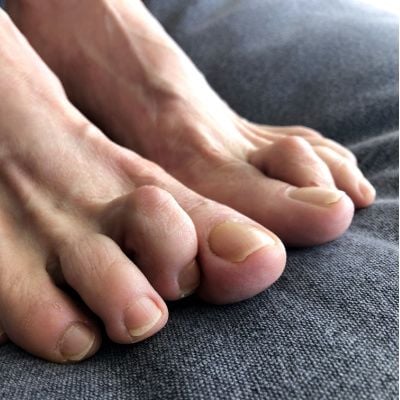 Hammertoes, a common foot deformity, can cause discomfort and affect the quality of life for those affected. In this comprehensive guide, we will explore the intricacies of hammertoes, shedding light on their causes, symptoms, diagnostic methods, and various treatment options. By providing a deeper understanding of this condition, we aim to empower readers with the knowledge to recognize, address, and seek appropriate care for hammertoes.
Hammertoes, a common foot deformity, can cause discomfort and affect the quality of life for those affected. In this comprehensive guide, we will explore the intricacies of hammertoes, shedding light on their causes, symptoms, diagnostic methods, and various treatment options. By providing a deeper understanding of this condition, we aim to empower readers with the knowledge to recognize, address, and seek appropriate care for hammertoes.
Unraveling Hammertoes
What are Hammertoes?
Hammertoes are a deformity where one or both joints of the second, third, fourth, or fifth toe become bent, resembling a hammer. This condition often results from an imbalance in the muscles, tendons, or ligaments that normally keep toes straight.
Causes of Hammertoes
- Foot Structure: Individuals with a high arch or flat feet may be more prone to developing hammertoes.
- Tight Shoes: Wearing narrow or ill-fitting shoes that force the toes into a bent position can contribute to hammertoe development.
- Genetic Factors: Some people may have an inherited tendency to develop hammertoes.
Recognizing Symptoms of Hammertoes
Toe Deformity
The most noticeable symptom of hammertoes is the abnormal bending of one or more toes, resembling a hammer or claw.
Corns and Calluses
The bent toes can rub against shoes, leading to the formation of corns or calluses at the top or tip of the affected toes.
Pain and Discomfort
Individuals with hammertoes may experience pain or discomfort, especially when walking or wearing shoes.
Diagnosing Hammertoes
Clinical Examination
Healthcare professionals conduct a thorough examination of the foot, assessing the appearance of the toes and identifying any signs of deformity.
X-rays
X-rays may be ordered to visualize the bones and joints, helping determine the extent of the deformity and guide treatment decisions.
Differential Diagnosis
Distinguishing hammertoes from other toe conditions, such as mallet toes or claw toes, is essential for accurate diagnosis and appropriate treatment planning.
Treatment Approaches for Hammertoes
Conservative Measures
Footwear Modification:
Switching to shoes with a roomy toe box and low heels can alleviate pressure on the toes, reducing discomfort.
Toe Exercises and Stretches:
Simple exercises and stretches can help strengthen the muscles and improve flexibility in the toes.
Padding and Orthotic Inserts:
Using pads or orthotic inserts can provide cushioning, prevent rubbing, and promote proper toe alignment.
Physical Therapy
Physical therapy may involve targeted exercises to strengthen toe muscles and improve joint flexibility.
Medications
Over-the-counter pain relievers or anti-inflammatory medications may be recommended to manage pain and swelling associated with hammertoes.
Surgical Intervention
For severe cases or when conservative measures fail, surgical options such as toe joint fusion or tendon transfer may be considered to correct the deformity.
Living with Hammertoes
Lifestyle Modifications
Adopting lifestyle changes, such as choosing appropriate footwear and performing regular toe exercises, can contribute to managing symptoms.
Monitoring and Follow-Up
Regular check-ups with healthcare providers are essential to monitor the progression of hammertoes, assess treatment effectiveness, and make adjustments as needed.
Prevention of Hammertoes
Footwear Selection
Choosing shoes with a wide toe box and avoiding high heels or shoes with tight toe space can help prevent the development or worsening of hammertoes.
Toe Exercises
Regularly performing exercises to strengthen and stretch the toe muscles can promote overall foot health and reduce the risk of hammertoes.
Emotional and Psychological Impact
Coping Strategies
Dealing with the impact of hammertoes on daily life may require coping strategies, such as seeking support from healthcare professionals and finding comfortable footwear.
Setting Realistic Expectations
Understanding that managing hammertoes is a gradual process and setting realistic expectations can contribute to a positive mindset.
Seeking Professional Guidance
Podiatrists and Orthopedic Specialists
Consulting with podiatrists or orthopedic specialists with expertise in foot conditions ensures a comprehensive assessment and personalized treatment plan. Regular follow-ups are essential for ongoing management.
Footwear Experts
Seeking advice from footwear experts can help individuals find shoes that provide proper support and accommodate the specific needs of hammertoes.
Conclusion
In conclusion, hammertoes, while presenting challenges, can be effectively managed through a combination of conservative measures, physical therapy, and, in some cases, surgical intervention. Understanding the causes, recognizing symptoms, and adopting appropriate treatment strategies empower individuals to actively participate in their care and make informed lifestyle choices. Proactive measures, coupled with awareness and education, form the cornerstone of a comprehensive approach to preventing, diagnosing, and managing hammertoes, allowing individuals to lead active and pain-free lives.
Disclaimer:
The information on this website is provided for educational and information purposes only and is not medical advice. Always consult with a licensed medical provider and follow their recommendations regardless of what you read on this website. If you think you are having a medical emergency, dial 911 or go to the nearest emergency room. Links to other third-party websites are provided for your convenience only. If you decide to access any of the third-party websites, you do so entirely at your own risk and subject to the terms of use for those websites. Neither Joseph Stuto, DPM, nor any contributor to this website, makes any representation, express or implied, regarding the information provided on this website or any information you may access on a third-party website using a link. Use of this website does not establish a doctor-patient relationship. If you would like to request an appointment with a health care provider, please call our office at 718-624-7537.




